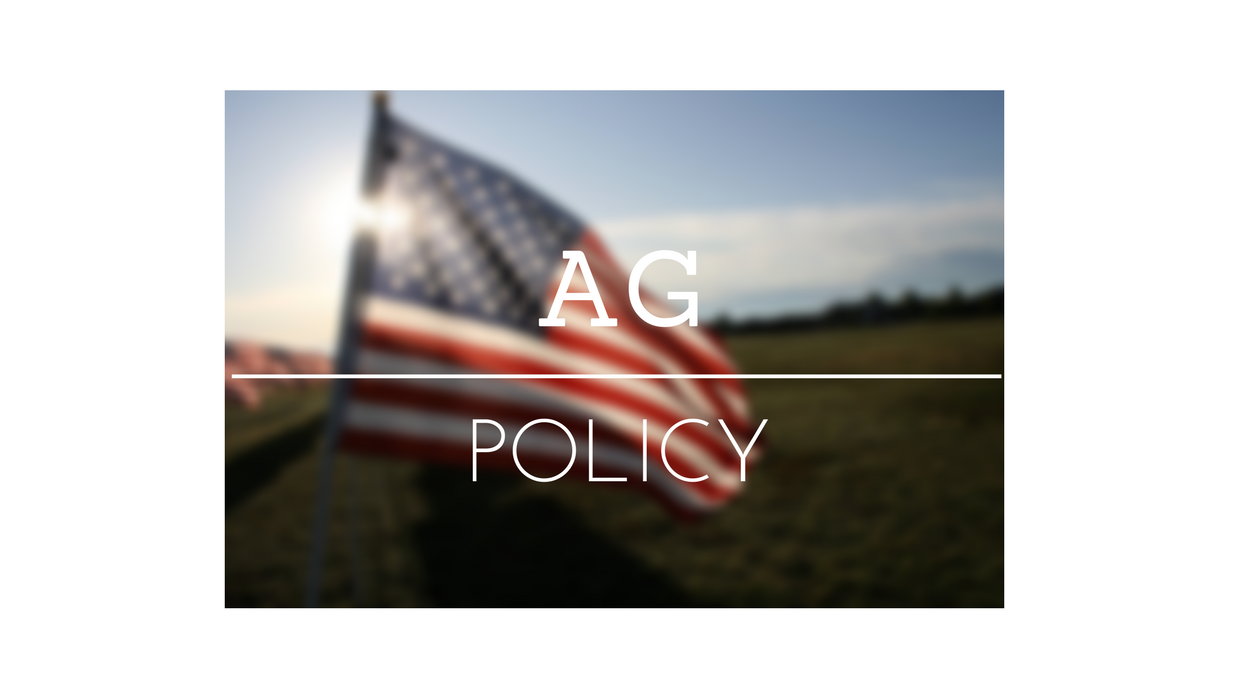In a recently released document, the Joe Biden administration is reverting to a water rule that existed prior to the contentious attempts by the Environmental Protection Agency and Corps of Engineers under President Barack Obama to change the definition in 2015. The next step will be for the two agencies to propose a new rule to replace President Donald Trump’s Navigable Waters Protection Rule, which in turn superseded Obama’s WOTUS redefinition.
But farm advocates are decrying “regulatory ping pong” and are worried about language that is still included in the new rule that could broaden regulation of waterways and the lands adjacent to them.
Originally, the Biden administration announced it was going to press ahead with making its own brand new WOTUS rule. This is a lengthy process requiring public hearings and analysis of the comments. The Trump administration had to go through the same process when it withdrew the Obama administration’s WOTUS rule and created the NWPR.
The latest move by the Biden administration brought swift reaction from farm state members of Congress. “The Obama era Waters of the United States rule would have been a disaster for North Dakota’s farmers and ranchers,” said Rep. Kelly Armstrong, R-ND. “Now, the Biden administration is trying to revive this failed one-size-fits-all policy that will destroy their livelihoods and decimate our rural communities. I will continue to advocate for policies that work with states, not against them, to achieve environmental progress.”
Sen. Kevin Cramer, R-ND, said, “It’s a shame the Trump administration’s rule was repealed at all. Americans deserve better than regulatory pingpong. I look forward to hosting EPA and the Corps of Engineers next week in Bismarck to give North Dakotans the opportunity to put our priorities in front of the Biden administration as the process moves forward.”
Sen. John Hoeven, R-ND, said, “The EPA’s proposal undermines the certainty we worked to provide with the NWPR (Department of Army’s Navigable Waters Protection Rule) and is part of President Biden’s efforts to impose burdensome and costly mandates under a new WOTUS definition. The Obama-era WOTUS rule was wrong for our nation, and our farmers, ranchers and energy producers, to name a few of the impacted industries, cannot afford a similar overreach from the Biden administration.”
Rapanos tangles
The Obama WOTUS rule brought massive opposition from farmers, landowners and ag and business groups, manifested in lawsuits from 36 states and dozens of private advocacy groups in several judicial districts, many of which were eventually consolidated. Obama’s WOTUS rule was suspended as soon as it became effective as the lawsuits worked their way through the courts. Many suits were still pending when they were rendered moot by the enactment of the Trump administration’s NWPR.
The controversy over what constitutes a “water of the United States” goes back decades. In 2006, in a contentious, fractured decision, Rapanos v. United States, the Supreme Court attempted to resolve the controversies but ended up adding to the confusion. The case involved a developer of 54 acres of land who was subject to penalty by the EPA for filling in “wetlands” without a permit. Rapanos, the developer, maintained the land was not a wetland under the Clean Water Act because it was not adjacent to navigable waterways. Rapanos’s case progressed through many appeals, with courts unable to agree about what was or was not a regulated wetland or waterway. At one point, Rapanos faced a possible 63 months in prison and was fined $5,000.
Separate decision
The Supreme Court proved no less divided. The Rapanos decision was split 4-1-4, with justices writing five separate opinions explaining why they voted the way they did. Justice Anthony Kennedy broke the tie, siding with the four justices favoring a broader interpretation of “waters of the U.S.” but wrote his own separate opinion. Kennedy’s reasoning was that a water feature on a property only had to have a “significant nexus” with a regulated waterway to be regulated itself, a vague phrase that has proved difficult to define.
Because it appeared to allow for a broader scope of regulation, the Obama administration relied on Kennedy’s opinion in crafting its WOTUS rule. But because that phrase appears only in Kennedy’s opinion, not in the rulings of the other four justices with whom he sided, it invited further legal challenges. Some courts have upheld that standard, while others have not. Shortly after Rapanos, the Ninth Circuit held in another case that Kennedy’s “significant nexus” test was the controlling law from the fractured Rapanos decision. But that ruling applied only to the Ninth Circuit’s jurisdiction.
Writing for himself and Justices Samuel Alito, clarence Thomas and John Roberts, the late Justice Antonin Scalia argued in a plurality opinion in Rapanos for a narrower interpretation of “waters of the U.S.” It was this narrower interpretation that the Trump administration went back to for support when rewriting its NWPR rule. The NWPR rule triggered its own cascade of lawsuits from environmental groups, which claimed it was weakening water protections.
Reversion to pre-2015 rule
In January, the Biden administration said it would first withdraw the Trump NWPR and revert to the 2015, pre-Obama rule; then write its own new rule.
After an Arizona federal court vacated the Trump-era NWPR on Aug. 30, 2021 (due to a lawsuit brought by environmental legal nonprofit Earthjustice on behalf of the Pasqua tribe) the EPA and Corps of Engineers released a 240-page document that said they were reverting to the pre-2015 definition.
However, the proposed new rule still allows either the use of the “significant nexus” definition—Kennedy’s—or the broader, agreed-upon definitions of regulated waters dating from the 1986 rule—Scalia’s—which the document calls the “relatively permanent standard.”
The key passage is this one: “Thus, in the proposed rule, the agencies interpret the term ‘waters of the United States’ to include: traditional navigable waters, interstate waters, and the territorial seas, and their adjacent wetlands; most impoundments of ‘waters of the United States’; tributaries to traditional navigable waters, interstate waters, the territorial seas, and impoundments that meet either the relatively permanent standard or the significant nexus standard; wetlands adjacent to impoundments and tributaries, that meet either the relatively permanent standard or the significant nexus standard; and ‘other waters’ that meet either the relatively permanent standard or the significant nexus standard.”
Waiting for next steps
That still leaves some confusion, since at least one circuit court, the 11th, has ruled that both tests cannot be used, but only the Kennedy “significant nexus” test. The Corps and EPA admit the new rule would still leave areas of contention: “While there are case-specific determinations that would need to be made under this proposed rule, that was also true under the NWPR and many other regulatory regimes where agencies must balance competing factors.”
In the meantime, all sides are waiting to see what the next step is, and what the EPA and Corps will propose to add to or expand the 2015 rule. “This is not the end of the process; it’s only a temporary measure,” said Damien Schiff, a senior attorney with the Pacific Legal Foundation who leads its environmental practice group. “They are not saving any of the controversial parts of either the Trump or the Obama rule,” because both had legal disabilities.
The PLF, which has been deeply involved in WOTUS litigation, has asked the Supreme Court to help resolve the ongoing confusion by taking up Rapanos again and ruling decisively in favor of the Scalia standard.
Part of the delay comes from the time it takes to create guidance documents interpreting the law, which can be created by agencies internally without public feedback and which some courts treat with deference. In cases where the legal language is vague, ambiguous or contentious, as in Rapanos, guidance documents can make a difference.
Zippy Duvall, president of the American Farm Bureau Federation, said, “AFBF is disappointed [that] EPA is returning to an overly complicated interim water rule. Overreaching regulations create major permit backlogs for the federal government and result in long delays for farmers and ranchers who are working to keep America fed. We are particularly concerned [that] EPA is bringing back the significant nexus test. This case-by-case test threatens to unfairly regulate large areas of private land miles from the nearest navigable water.
“It’s troubling that EPA is putting a framework in place before completing the promised stakeholder engagement. [EPA] Administrator [Michael] Regan pledged to listen to the needs of farmers and ranchers and committed to a rule that is not overly burdensome. We urge him to stay true to his word.”
David Murray can be reached at [email protected].



